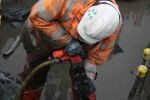 Companies in the oil and gas sector working to protect employees from hand arm vibration risk are losing large sums of money with ineffective paper-based HAV monitoring systems or by simply not implementing a HAVS policy.
Companies in the oil and gas sector working to protect employees from hand arm vibration risk are losing large sums of money with ineffective paper-based HAV monitoring systems or by simply not implementing a HAVS policy.
Administration and workforce interruption involving manually logging, recording and monitoring hand-arm-vibration risks can cost many tens of thousands of pounds a year even though the process is prone to human error and other inaccuracies.
Also the legal risk and HSE compliance is not being effectively managed due to the abuse and imprecision of using a paper based system or from poor monitoring. The costs have been revealed by the company, who have already helped companies of all sizes to improve safety, whilst reducing both cost and risk to workers and employers.
The firm’s reputable HAVmeter solution accurately monitors vibration exposure levels from tools and automates the procedure to provide reports in simple and usable formats. That means individual workers are spared the responsibility of meticulously filling out log sheets whilst management saves time collecting and analysing data.
Reactecs own research with its customers has shown that by using the HAVmeter solution, efficiency of monitoring vibration improves by up to 25% thanks to accurate and easy record collection and reporting.
That level of accuracy is vital to businesses to enable them to make decisions to further develop and manage HAVS. Research from the HSE has shown that every 1000 paid out in claims costs a company between 7000 and 36,000 in legal and other costs and often due to the difficulty of obtaining correct, quality data from paper systems.
Gary Kennedy, roads manager with Amey in North Lanarkshire, said: “Before the HAVmeter, we relied on manual input, with a worker basically using his memory at the end of the day for the time that he has spent using vibratory tools.”
While the vast majority of employers are committed to addressing HAVS risks, the nature of the work environment means tool operators may only be equipped to provide a rough estimate of their tool usage, with logs then going through a long and costly administrative process.
Vague estimates contribute to false calculations, compromising the validity of the time and money spent collating and processing the information gathered.
Operators can over estimate HAV exposure up to 80% resulting in downtime or increased operator overheads. When operatives report such inaccurate data health and safety managers cannot efficiently manage HAVS and will also put the company at a further litigation rise.
It can also result in removing operatives from a project causing project delays and additional cost from overtime, coverage and eventual replacement.
Jim O’Hagan, managing director, said: “By using better technology, companies are ensuring the protection of their employees, as well as saving themselves money.
If companies make staff welfare a key priority it will be beneficial not only to the staff involved but it can also save them money and provide a return on cost. In turn this will make it easier for health and safety managers to obtain budget in the future.”
Under the system, every employee before a shift is issued with an individual HAVmeter that records their exposure from tool usage in order to keep them within the limits set out by the Health and Safety Executive (HSE).
More information can be found at www.reactec.com



